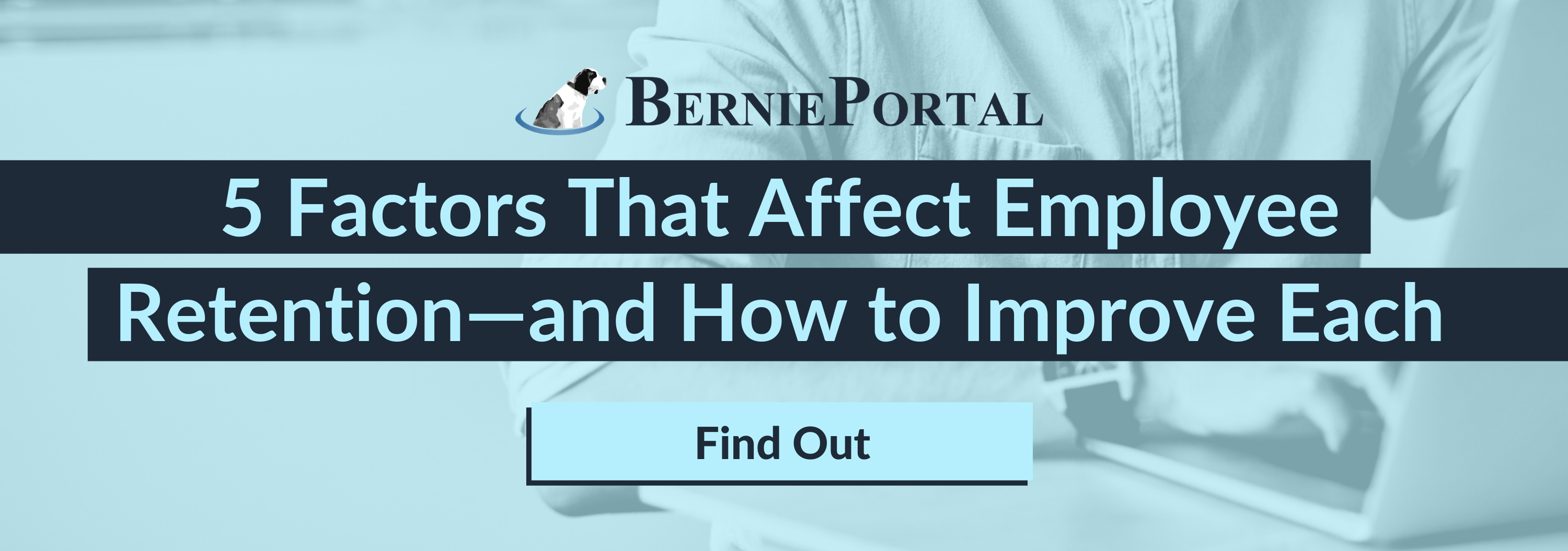
Written by
Lauren Brown
Lauren is an aPHR®-certified member of the Marketing team at Bernard Health. She writes about healthcare insights, employment law, and HR solutions.
How Your PTO Policy Impacts Retention

While some degree of turnover is expected in most organizations, experts are predicting a wave of widespread turnover after vaccine efforts help workers feel more confident about making career moves. If this proves to be the case, retention efforts will need to be top of mind for employers going into this summer. Is your organization’s paid time off policy helping or hurting your retention efforts? Read on to find out.
What is Retention and Why is it Important in 2021?
Employee retention refers to an organization’s ability to keep its employees and is usually represented as a percentage that is calculated on an annual basis. Retention rate is calculated by dividing the number of employees who have been in their position a year by the number of employees in the position a year ago.
Conversely, turnover is natural to a certain extent—there will always be employees who leave jobs to start new ones. However as vaccination efforts ramp up across the country, a report indicates that a massive wave of turnover is expected once the pandemic is more under control and employees feel safe making a career move.
One way employers can improve retention this year is focusing on policies that impact employees’ wellbeing and work-life balance, like paid time off.
How Can Employers Improve Retention Through PTO?
While there aren’t any federally-mandated PTO laws for most employers, a strong paid time off policy helps retain current talent and attract prospective candidates. Furthermore, employers also provide employees PTO as a way to combat employee burnout, increase productivity, and boost morale.
The following are actionable ideas for using PTO as a tool to improve retention:
1. Audit Your PTO Policy
How should small and mid-sized employers structure their paid time off approach? This question can significantly impact the administration of PTO—and can also impact employee satisfaction. PTO policies require regular review for companies to remain competitive, compliant, and financially solvent. From an unlimited PTO policy to lump sum and accrual approaches, there’s a lot to consider if your organization needs to choose a new PTO policy approach.
2. Communicate Changes with Employees
Employees may not like the current PTO policy or they may not be happy with any changes that you make, depending on the type of policy that your organization had in place before your audit and update. That’s okay. It’s HR’s job to clearly communicate changes and address any questions that employees may have.
If changes are made to your organization’s PTO policy, explain the reasons for the audit, be prepared for questions, and use this template to communicate those changes. Employers can also help by establishing open dialogue and communication while addressing questions through 1-to-1 meetings.
3. Allow PTO for Vaccinations
In a fact sheet issued by the Biden administration, the White House announced a new paid leave tax credit designed to incentivize employers to encourage their employees to get a COVID-19 vaccination. Employers can offer paid leave that includes both time off for employees to actually get the shot(s) and also any necessary recovery time. Employees won’t have to worry about how they’ll afford time off to get the vaccine, and employers can rest easy knowing that their workforce is taking a step to stay healthy against the COVID-19 pandemic.
What are Common Approaches to PTO?
Companies structure their policies in different ways depending on the company’s size and industry. If your organization is considering making a change to your PTO policy, here are the most common approaches:
- Lump Sum PTO Policy (Annual Allotment): Under this strategy, employees are granted a specific number of days per year that either expire or roll over based on a particular date. This date is typically January 1, or the employee’s hire date.
- Accrual Bank PTO Policy: With the accrual bank approach, the policy is not based on a fixed date and there are no rollover days. Instead, employees accrue PTO, typically on a monthly or quarterly basis. There is usually a “positive limit” of accrual dates, after which no more days can be accrued until some are taken.
- Unlimited PTO: Unlimited PTO plans are structured so that employees decide when to take paid time off. The employer provides little-to-no parameters in this type of plan. As long as employees accomplish tasks as expected and the organization does not suffer negatively, they can decide how to use PTO.

Written by
Lauren Brown
Lauren is an aPHR®-certified member of the Marketing team at Bernard Health. She writes about healthcare insights, employment law, and HR solutions.
Related Posts
We just wrapped up another phenomenal Weekdays with Bernie (WWB) Conference!
Employees are the heart and soul of an organization, and valuing their opinions can have...
HR parties of one already have an abundance of tasks to keep up with. From hiring to...
The talent search is no longer a skirmish or a battle. It’s a WAR! As a strategic HR...







Submit a Comment